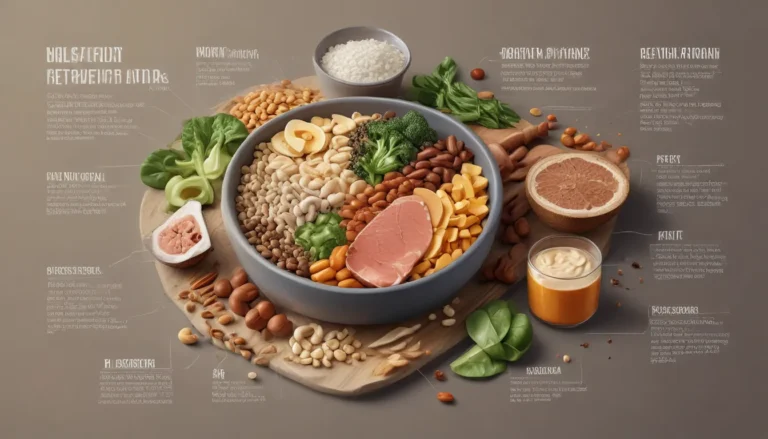The pictures in our articles might not always show exactly what the text is talking about. We use these images to make the article more interesting and eye-catching. They are there to add to the text, but not to replace it or show every detail.
If you're a fan of Italian cuisine, you've likely indulged in the delightful flavors of gnocchi at some point. These small, pillowy dumplings made from potatoes, flour, and sometimes eggs have found their way into the hearts and stomachs of food enthusiasts worldwide. But beyond its scrumptious taste and versatile nature, gnocchi also offers a range of nutritional benefits that are worth exploring. In this article, we'll delve into the 18 gnocchi nutrition facts that shed light on the health aspects of this beloved dish. Whether you're a dedicated gnocchi enthusiast or simply curious about its nutritional profile, this guide will equip you with the insights you need to make informed choices about incorporating gnocchi into your diet.
Understanding Gnocchi Nutrition: Unveiling the Health Secrets of this Italian Delight
Gnocchi is more than just a flavorful addition to your plate – it's also a source of essential nutrients that can contribute to your overall well-being. Let's break down the key nutritional aspects of gnocchi to help you make informed decisions about enjoying this classic dish.
Calories:
With approximately 130-150 calories per 100 grams, gnocchi is a relatively calorie-dense food. While this may seem high, it's important to consider portion sizes and balance your meal to fit your dietary needs.
Carbohydrates:
Gnocchi is rich in carbohydrates, providing around 25-30 grams per 100 grams. Carbs are a vital source of energy for your body, so enjoying gnocchi in moderation can be a satisfying way to fuel your day.
Protein:
While not a significant source of protein, gnocchi typically contains 3-5 grams per 100 grams. Pairing gnocchi with protein-rich ingredients can help balance your meal and support muscle health.
Fat:
Gnocchi is relatively low in fat, with approximately 1-2 grams per 100 grams. Opting for light sauces or incorporating healthy fats like olive oil can help maintain a balanced diet.
Fiber:
Gnocchi is not a significant source of dietary fiber, with only about 1 gram per 100 grams. Supplementing your meal with fiber-rich vegetables or whole grains can enhance your digestive health.
Vitamins:
Gnocchi is a good source of vitamins like vitamin C, vitamin B6, and vitamin A. These essential nutrients play a crucial role in supporting your immune system and overall health.
Minerals:
Loaded with minerals such as potassium, calcium, and iron, gnocchi provides essential elements that are vital for various bodily functions.
Sodium:
It's important to note that gnocchi can be high in sodium, so be mindful of your intake, especially if you're following a low-sodium diet.
Gluten-Free Options:
If you're gluten-sensitive or have celiac disease, there are gluten-free versions of gnocchi available that are typically made with alternative flours like rice flour or almond flour.
Varieties, Cooking Methods, and Dish Pairings:
Gnocchi comes in various flavors and ingredients, can be prepared through boiling, baking, or pan-frying, and pairs well with a variety of sauces and ingredients, offering versatility and creativity in your culinary endeavors.
Homemade Gnocchi:
Embark on a fun culinary project by making homemade gnocchi, allowing you to customize flavors and ingredients to suit your preferences.
Texture and Shelf Life:
Gnocchi boasts a unique texture that is soft and chewy on the inside, yet slightly crispy on the outside. However, it has a relatively short shelf life and is best consumed fresh or frozen for longer storage.
Nutritional Benefits and Moderation:
Gnocchi provides a good source of energy and essential nutrients, making it a satisfying and nutritious meal option. Remember to consume gnocchi in moderation as part of a balanced meal plan.
Embracing Gnocchi in Your Diet: Tips for Enjoying a Healthy and Flavorful Dish
Now that you're familiar with the nutritional aspects of gnocchi, let's explore some tips for incorporating this delectable dish into your diet in a healthy and enjoyable way.
- Moderation is Key: While gnocchi can be a delicious addition to your diet, it's essential to enjoy it in moderation as part of a balanced meal plan.
- Choose Healthy Sauces: Opt for nutritious sauces like tomato sauce, pesto, or creamy mushroom sauce to enhance the flavor and nutritional value of your gnocchi.
- Homemade Goodness: Consider making homemade gnocchi to control the ingredients and customize the flavors to your liking.
- Pair with Nutritious Ingredients: Combine gnocchi with nutrient-rich ingredients like vegetables, lean proteins, and healthy fats to create a well-rounded meal.
- Explore Gluten-Free Options: If you have gluten sensitivities, explore gluten-free gnocchi varieties for a safe and flavorful dining experience.
- Watch Your Sodium Intake: Be mindful of the sodium content in gnocchi and opt for low-sodium sauces or seasonings to keep your overall intake in check.
By following these tips, you can savor the delicious flavors of gnocchi while reaping its nutritional benefits and maintaining a balanced approach to your dietary choices.
Answering Your FAQs: Common Questions About Gnocchi Nutrition
As you embark on your journey to discover the nutritional value of gnocchi, you may have some questions in mind. Here are some common FAQs answered to provide you with clarity and guidance:
Q: Are gnocchi gluten-free?
A: Traditional gnocchi recipes contain gluten, but you can find gluten-free alternatives made from flours like rice, corn, or chickpea flour.
Q: How many calories are in a serving of gnocchi?
A: The calorie content of gnocchi can vary based on ingredients and portion size, with an average of 150-200 calories per cup of cooked potato gnocchi.
Q: Can gnocchi be made with vegetables?
A: Yes, gnocchi can be crafted with various vegetables like sweet potatoes, spinach, or butternut squash to add nutritional value and flavor diversity.
Q: Is gnocchi a healthy option?
A: Gnocchi can be part of a healthy diet when enjoyed in moderation and paired with nutritious ingredients. Opting for whole-wheat or gluten-free varieties can enhance its health benefits.
Q: How can I store leftover gnocchi?
A: To store leftover gnocchi, refrigerate them in an airtight container for 3-4 days or freeze them for longer storage. Follow proper reheating instructions before consumption.
Conclusion: Embrace the Nutritional Riches of Gnocchi in Your Culinary Adventures
In conclusion, gnocchi is not only a delightful and versatile dish but also a source of essential nutrients that can contribute to your overall well-being. From providing energy and vital nutrients to supporting various bodily functions, gnocchi offers a range of health benefits that make it a valuable addition to your diet. By enjoying gnocchi in moderation, choosing healthy sauce options, and exploring homemade or gluten-free varieties, you can savor the flavors of this Italian delight while nourishing your body in a balanced and fulfilling way. So go ahead, indulge in the aromatic and savory essence of gnocchi while embracing its nutritional riches on your culinary journey.






